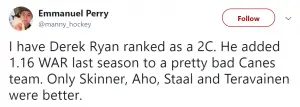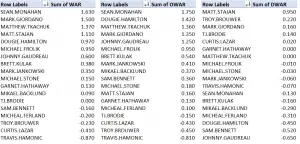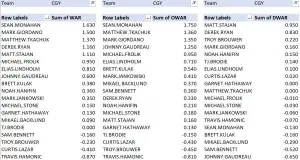Social media can be a cavernous and spooky place, chalk filled with great hockey minds, fringe opinions and a lot of extremes. Often these extremes can manifest around the same topic, with fans changing sides in minutes based on a fringe statistic or analysis.
When Bill Peters was on Calgary radio earlier this week he was asked about Derek Ryan, to which he admitted they’d like to bring him to Calgary. The comments set off a backlash from many about bringing his own people in. How many terrible Hurricane players do you need in Calgary? Not another fourth line player in his 30s. What are the Flames doing?
Derek Ryan is the current lightning rod, and acts as a pretty interesting study into statistics and how they could be or are being used to weed out signing and trade targets in the National Hockey League.
Who is Derek Ryan?
Derek Ryan is a 31 year old right shooting center that found his way to the NHL through the CIS, not the most conventional path. He’s only played 153 NHL games after a stint in Europe. He’s finally arrived.
Last season he put up 15 goals and 38 points, which is pretty good production for a depth forward. He gained Bill Peters trust.
He led the Hurricanes in CF%, was third in scoring chance splits, and 1st in high danger % for a team that missed the playoffs once again. (Noah Hanifin was 3rd, 1st and 5th by the way)
His relative numbers had him 1st in CF, 3rd in scoring chances and 1st in high danger chances as well. He was one of the Hurricanes better players in all those measures.
What makes the Ryan case interesting however, was all of this didn’t matter in social media this week, as the view of Ryan was a mistake following a bigger mistake, that of the Dougie Hamilton trade in a rough couple of days in Calgary. The Flames were bringing in a Peters guy, in the wake of a terrible trade that brought in other Peters’ guys on Saturday.
That is until someone changed the narrative.
Last night Manny Perry, owner the of the site Corsica Hockey, a staple in the analytics community suggested Derek Ryan is actually a second line center based on his analysis of the hockey equivalent to baseball’s WAR, or Wins Above Replacement.

Corsica has been a staple for years for anyone that loves to dig into hockey stats, and his WAR model is just that a model. Any time you add up hockey stats in some fashion and it spits out an answer it’s the hockey numbers equivalent to a hypothesis, one that can and should be tested against various players.
Derek Ryan’s WAR value of +1.16 is solid, and is based on an offensive WAR of +0.33 and a defensive WAR of +.83. But what does that mean exactly? Do we believe it? Is this a valuable statistic? Does this player actually add a victory to a hockey team in a season?
In this case the offensive side of things is made up of shot rates for, the quality of shot for, shooting, penalties drawn, and offensive finish. The defensive side are the same against.
It’s a start.
Testing Teams
One way to test his data is to look at teams as a whole both defensively and offensively.
The average OWar for NHL teams has Pittsburgh, Winnipeg, Tampa, Washington, Vegas and San Jose at the top. That’s a good sign. At the bottom you’ll find Arizona, Buffalo, Detroit, Ottawa, St. Louis and Vancouver. Clearly the offensive number on a team level works.
The average DWar has Minnesota, St. Louis, Tampa, Boston, Dallas and Winnipeg as stalwarts, while the bottom sieve teams include the Rangers, Senators, Blackhawks, Islanders and Oilers. Once again this seems to add some credibility.
From a Flames perspective this stat makes more sense than traditional analytics as the Flames are 19th offensively, and 20th defensively, which puts them 22nd in the league in total WAR a spot pretty close to how they finished in the standings. Remember the club was essentially top five in CF%, and their splits both in scoring chances and high danger chances.
So at this point the WAR model certainly makes more sense as a proxy to standings than last year’s possession numbers.
So can we use this model to look at the trade itself?
The Big Trade
Putting Derek Ryan aside for a moment, it’s also interesting to see the recent blockbuster trade in WAR statistics and how it affects the Flames breakdown.
Prior to the deal the Flames roster broke down like this; (click on image)
Some things jump off the page when you examine the rankings.
Sean Monahan was in a class of his own offensively. In fact he’s well ahead of his gifted winger in Johnny Gaudreau when it comes to the weightings in the Corsica WAR model, and ahead of the next grouping that would include the departed Dougie Hamilton, Matthew Tkachuk and Mark Giordano.
So why is that? In the Gaudreau/Monahan example its pucks to the net, with Monahan having a huge shot rate value and Gaudreau being closer to zero (the average NHLer). When it comes to every other offensive category they’re similar with Gaudreau drawing more penalties to prop his numbers up.
Defensively the Flames were led by Matt Stajan, something that certainly meets my eye test from last season. His shot and quality shot suppression rates were off the charts for the Flames suggesting the only thing wrong with Matt Stajan last year was his pay cheque. Next up is the maligned Troy Brouwer, who to a much lesser degree was like Stajan in not giving up that much when he was on the ice, at least compared to the average NHLer.
On the negative side you have Johnny Gaudreau at -0.81, a number made up almost entirely by his suppression numbers both of which were the team’s worst.
Other culprits included Hamilton and Sam Bennett, two players that had decent shot suppression numbers but are hammered by their penchant to take minor penalties, and Micheal Ferland who put up shot rates against similar to Gaudreau, in fact he was second worst on the team; both players well worse than their center Monahan.
The trade takes two of the team’s worst DWar players; Hamilton for his penalty totals and Ferland for his suggested lack of defensive acumen off the roster and replaces them with two players that seem to have an above average overall game.
Here’s a look at the Flames with the trades and the assumed Derek Ryan signing;
As you’d expect, the Flames lose a key player offensively in Dougie Hamilton, but then gain three of their top seven defensive players by the deal and expected signing of Derek Ryan.
The Flames have Wins Above Replacement adds both offensively and defensively from all three players.
In fact if you look just at the traded players on last year’s statistics it’s a win for the Flames as the reduction of a player that adds a full win by himself and a player that gives 1/5 of a win away (a total loss of +.75 WAR) for two players that both contribute; Elias Lindholm isn’t that far off of Hamilton in total WAR at +0.81 and Noah Hanifin adds +.36 for a total of +1.17 WAR.
Assessing the Flames Core
And finally, lets take the model a step further and look at the Flames’ core and their warts in contributing to winning hockey games.
The Flames core up front would have to come down to five players; Sean Monahan, Johnny Gaudreau, Matthew Tkachuk, Mikael Backlund and the recently acquired Elias Lindholm.
Of this group of forwards only Lindholm and Tkachuk are holding their own defensively, while hurting the team in their own zone, Gaudreau to a fairly significant level. Mikael Backlund is somewhat surprising, but he too like Hamilton drew too many penalties last season.
On the blueline the Flames top four features an elite defenseman in Mark Giordano who literally wins +1.5 games on his own. Hanifin is number two in impact, followed by TJ Brodie at zero flat. The leak in the group is Travis Hamonic who is -0.87 War, entirely due to shooting as a negative in his offensive numbers. A look deeper into that statistic shows a lot of defensive defensemen that don’t have a lot of attack game in their arsenal.
Right This Is Supposed to be About Derek Ryan
Derek Ryan looks to be about as sound a free agent signing as there can be when you think of the stupidity that generally comes along with Canada Day.
He won’t cost a tonne, he shouldn’t get ridiculous term, and he measures up as a solid depth signing in pretty much any way you’d look at him including counting stats, possession metrics and Manny’s WAR system.
Get it done.
The Flames have taken some interesting steps forward this summer in making the team more solid defensively, and bringing better balance to their lineup.
It will be interesting to see what other changes are to come.






